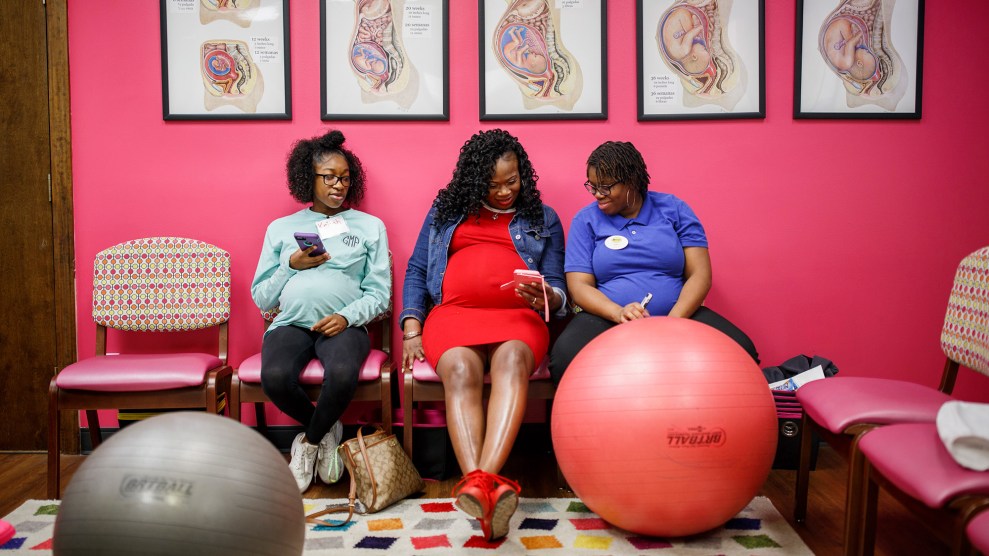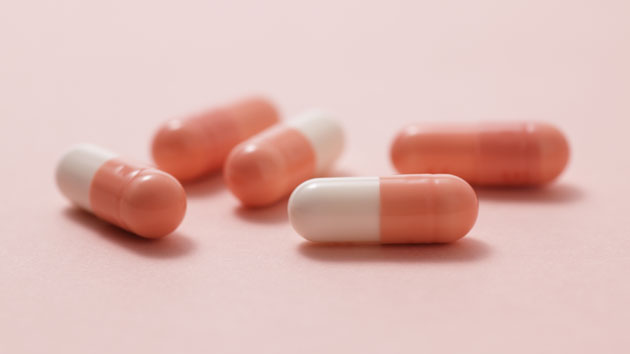
George Peters/Getty Images
This story was originally published by Undark and is reproduced here as part of the Climate Desk collaboration.
In the fall of 2016, sex therapist and researcher Leonore Tiefer shuttered the New View Campaign, an organization she had founded to combat what she refers to as “the medicalization of sex”—essentially, the pharmaceutical industry’s efforts to define variations in sexuality and sexual problems as medical issues requiring a drug fix.
For 16 years, the group had fought against industry’s involvement in sex research, including its push for a drug to boost women’s sex drives. New View hosted conferences and its members penned papers and testified before the United States Food and Drug Administration. The campaign was prominently featured in an 80-minute documentary called Orgasm Inc, and promoted a clever (if off-pitch) video advising women to “throw that pink pill away,” a reference to the female-libido drug flibanserin (Addyi), which was seeking FDA approval at the time.
Indeed, four years later all was quiet when the FDA approved bremelanotide (Vyleesi), a libido drug that women inject into their abdomen or thigh at least 45 minutes before sex. The study results had been decidedly unimpressive: Participants who received the drug didn’t report more satisfying sexual events than those getting a placebo shot, and they scored only slightly better on measures of desire. Further, four out of 10 women taking the drug reported that it made them nauseous.
“There really was no opposition in 2019,” said Tiefer, speaking for herself and others that had spoken out against flibanserin’s approval. “We all had pink Viagra fatigue of one sort or another.”
In March, the Journal of Sex Research published an analysis casting doubt on the methodology behind the two pivotal studies of bremelanotide. The study’s author, Glen Spielmans, a psychology professor at Metropolitan State University in Minnesota, accused industry-sponsored researchers of cherry-picking favorable findings. Reinvigorated by this new paper, Tiefer reached out to a few like-minded colleagues to “make a little noise.”
In his analysis, Spielmans points out that researchers dropped sexually satisfying events as a primary measure of effectiveness in the bremelanotide trials after the studies were complete. Women in the bremelanotide group didn’t report having more good sex, so relying on those results could have sunk chances of approval. That’s only one of the ways the researchers—all of whom had ties to Palatin or AMAG Pharmaceuticals Inc., the company that licensed bremelanotide—failed to adhere to widely accepted guidelines, according to Spielmans. (According to a press release, Palatin and AMAG mutually terminated their license agreement for Vyleesi in January of last year.)
“The risk you run is that they are simply kind of slicing and dicing through the data until they find something that makes the drug look good,” he said.
To prevent that type of cherry picking, researchers are supposed to decide on the endpoints at the beginning of the study. To be fair, the FDA okayed the change in primary outcome measures based on the updated 2016 guidance. And there’s no evidence that anyone “peeked” at the results before changing the endpoints. Still, in its review of the bremelanotide data, the FDA notes that because, overall, women in the study didn’t report more sexually satisfying events, the negative findings for that measure may have been obvious even before analyzing the data to find out who got the drug and who got a placebo.
The research team’s rebuttal published in the Journal of Sex Research was indignant. Researchers said that they changed outcome measures with the FDA’s blessing prior to analyzing results. They also accused Spielmans, who has no research or clinical expertise in sexual medicine, of being out of his depth. (I contacted several of the researchers, all of whom either did not respond to my request for an interview or declined to talk to me.) Spielmans answered in the same journal that he was “disappointed” because the research team “failed to engage with the most pressing concerns raised in my re-analysis.”
Its tricky business gauging a woman’s sexual desire. The bremelanotide trials asked women to tally sexually satisfying events (that includes masturbation and fun sexual activities with a partner) each month, but wound up prioritizing more subjective measures. For example, one of the primary endpoints on the bremelanotide trials is based on women’s answers to two questions about their sexual desire over the last month from a 19-item survey:
- Over the past four weeks, how often did you feel sexual desire or interest? [Almost always or always; Most times (more than half the time); Sometimes (about half the time); A few times (less than half the time); or Almost never or never.]
- Over the past four weeks, how would you rate your level (degree) of sexual desire or interest? [Very high; High; Moderate; Low; Very Low, or None at all.]
At the risk of oversharing, I have no idea how to answer those questions. Feeling sexual desire “less than half the time” results in a lower score. But what can I say? I work. We’re in a pandemic. My long-time husband (whom I love dearly) and I have been locked in pretty much 24-7 for a year and a half. Sparks don’t fly every time we pass in the kitchen.
To score high, you need to desire sex all, or nearly all, the time said Adriane Fugh-Berman, M.D., a professor of pharmacology and physiology at Georgetown University in Washington, D.C. “I show that slide in talks because I can usually get laugh from the audience by saying I don’t think this is consistent with having a job or being a full-time student,” she said. “Sexual desire all of the time? Like really?”
Even the FDA is somewhat incredulous of the ratings scale, stating in the 2016 guidance to drugmakers: “it’s unclear whether women experiencing sexual desire all or most of the time would identify this as a benefit, or whether this could represent a different concern to women.”
Still, the agency approved bremelanotide based, in part, on study results showing that women who injected themselves with the drug scored an average of 0.3 points higher on a 6-point scale of desire than the placebo group. The treatment group also scored about 0.3 points better on a 4-point scale measuring how bothered they were by low sexual desire.
The way we attempt to measure sexual dysfunction is heavily influenced by the pharmaceutical industry, said Fugh-Berman, who is an outspoken critic of pharmaceutical marketing practices and medication overuse. So, too, is our notion of the prevalence of the problem, she said. For example, the source of an oft-cited statistic that nearly half of American women are beset by some form of sexual dysfunction is a survey from 1999. As Undark reported in 2016, two of the three researchers were linked to drug companies and other scientists have questioned the methodology. “The so-called epidemic of female sexual dysfunction is a lie,” said Fugh-Berman.
Maureen Whelihan, a gynecologist in Greenacres, Florida who specializes in sexual medicine, also doesn’t take much stock in the questionnaires used in clinical trials. In practice, she may use short screeners to check for anxiety, depression, and how satisfied a woman is with her sex life. Then she dives into a conversation with patients about how to address their concerns. Sexual dysfunction is a complex problem that is often intertwined with mood disorders, but along with diet, exercise, and counseling, female-libido drugs can also play a role in treatment, she told me: “I’m always a believer of an approach that really includes all parts.”
If women do have a vast unmet need to boost libido, the available medications apparently aren’t filling it. Shortly after the FDA approved flibanserin, Valeant Pharmaceuticals (now Bausch Health Companies) bought Sprout for $1 billion. After two years of dismal flibanserin sales, and facing a lawsuit, Valeant sold the company to a group of former Sprout shareholders in exchange for a small royalty on future sales.
Sales have since increased with doctors writing more than 27,000 prescriptions for the drug so far this year compared to only about 6,000 prescriptions in 2018, according to the health analytics company IQVIA. Still, that would treat only a fraction of the women Sprout claims suffer from low desire. “In fact, there was not this groundswell of women clamoring for this drug,” said Fugh-Berman. “That was a public relations fiction.”
In the third quarter of 2021, Palatin reported netting only about $89,000 from sales of Vyleesi.
Whelihan routinely prescribes flibanserin, she said, although most patients don’t wind up taking it long term. She has offered to prescribe bremelanotide, but when women hear that it’s a shot that frequently causes nausea, most want no part of it, she said: “It went across sort of like a lead balloon.”
As for Tiefer, she’s still looking for ways to “make noise” about female libido drugs, through journal articles and editorials as well as talking to journalists like me. At this point, she’s not expecting to have much impact on the FDA’s decision making. “The goal is to raise the public’s awareness that these drugs are promoted by interested, profit-oriented parties,” she said, “and that the consumer, the patient, needs to be smart and not duped.”















